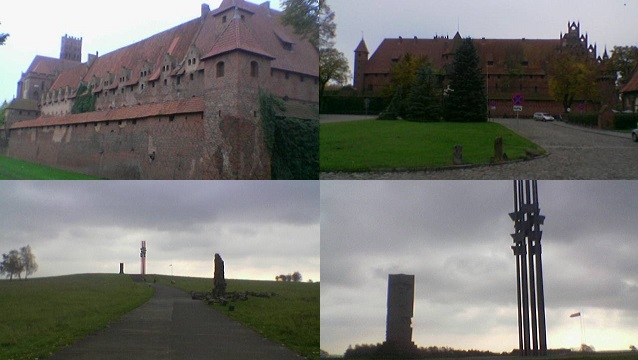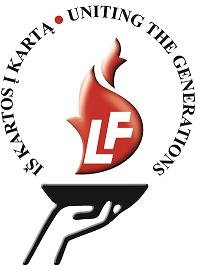Northern Poland: Former Germany’s East
Before World War 2 most of today's northern Poland was ethnically and politically German.
During the 13th-15th centuries, pagan Lithuania fought a seemingly eternal war against the German Teutonic Knights who sought to spread Christianity (according to critics, more likely to loot and destroy). Their headquarters was Malbork (Marienburg) castle, today rebuilt for better imagination of knights' lifestyle.
The largest of the battles against the crusading knights took place in Grunewald (known as Tannenberg in Germany, Žalgiris in Lithuania). ~70 000 soldiers participated in this one of the largest medieval battles where a united Lithuanian and Polish force vanquished the Teutonic Knights. The battlefield is now a popular tourist place with medieval souvenirs and a megalomanic monument. The battle has great importance in Lithuania as many streets and sports franchises are named after it, including the most powerful basketball (Žalgiris Kaunas) and football (Žalgiris Vilnius) teams.

Sites reminiscent of the crusading Teutonic Knights: formidable red-brick Malbork castle (top) and an atmospheric Žalgiris battlefield with its monuments, the metal-poles one covered with coats of arms of all the regions that amassed anti-crusader armies in that battle (bottom). ©Augustinas Žemaitis.
In Soldin forest near Myslibisz, a plane "Lituanica" crashed in 1933. Piloted by Steponas Darius and Stasys Girėnas this plane flew succesfully over the Atlantic with destination in Kaunas only several hundred kilometers away. It was the second longest flight time today, first Lithuanian plane to cross the Atlantic and the world's first transatlantic airmail service (the mail did not burn and was symbolically flown from the crash site to Lithuania the next day). The pilots became martyrs and even the Nazi Germany permitted construction of the Lithuanian pilots monument (two interlinked crosses) at the crash site in 1936 despite the German claim over Klaipėda region which shattered Lithuanian hopes to participate in Berlin Olympic games the same year. The monument has original German and Lithuanian plaques. After World War 2 when the lands were added to communist Poland a Polish plaque was installed. Curiously the monument survived even the iconoclastic communist regime and remained a place of respect. A traditional Lithuanian chapel-post now stands at the place where Steponas Darius body was discovered; a memorial barn is nearby.
The Gdansk-Sopot-Gdynia tri-city is now famous for its three supermuseums, very large and modern. Each of them is at least somewhat related to Lithuania. European Solidarity Center tells the story of the Solidarity movement that eventually deposed Polish communism. However, it also covers the entire life under the communist system, as well as the collapse of communism. Each ex-communist-ruled nation, including Lithuania, is dedicated a stand.
Second World War museum (Gdansk) also covers the events that influenced Lithuania. The museum is controversial, though: its original creators were from outside Central/Eastern Europe and their knowledge of local history proved to be superficial. Some exhibits were partly based on Soviet propaganda. Seeing this, the Polish government initially refused to open the museum but later opened it after rectifying the anti-Polish exhibits. Sadly, although anti-Polish claims were removed, anti-Lithuanian claims, as well as Soviet-propaganda based claims or spins about many other nations of the region, have remained. So, for instance, the very first quote about Lithuanian freedom fighters is that "Some of them were Nazi collaborators", etc.
The third supermuseum is Museum of Emigration in Gdynia. While it specifically deals with Poland's emigration, since ~1860 Poles and Lithuanians basically emigrated to the same destinations (even to the same cities and towns of the USA), so much of what is presented is also applicable to Lithuanians. Furthermore, some of the 19th-century Polish diaspora figures are considered to have been Lithuanian diaspora figures by Lithuanians: that is because Poland-Lithuania was a united country until 19th century and there were many people of Lithuanian origins who spoke Polish due to linguistic shift; these are now often considered to have been Poles by Poland and Lithuanians by Lithuania.
East of Gdansk one may visit Stutthof Nazi concentration camp, now a museum. It is rare among the concentration camps in that Jews did not make the majority of prisoners here. Instead, the camp was used to imprison many ethnic Lithuanians, Latvians, and Estonians who were seen as anti-Nazi, including leftist writer Balys Sruoga and politician Jonas Noreika. Balys Sruoga wrote a black-humour-filled book "Dievų miškas" (Forest of Gods) about the camp, which is seen as a Lithuanian literary classic due to its uniqueness in still being able to look at the world in a somewhat non-serious way despite the great suffering. Inside the concentration camp one may still feel the horrible atmosphere they suffered.






Leave a comment